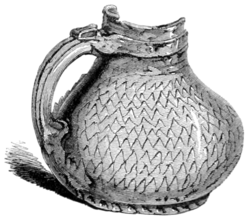714 inches, entirely covered with inscriptions, arranged so as to form ornamental designs; on the underside are the twelve signs of the Zodiac, and inscriptions introduced in like manner over the whole surface.
By the Rev. E. Wilton.—Drawings of some relics lately found in Wiltshire, accompanied by the following notice:—"On Charlton Down, of which Sir Richard Colt Hoare says, that traces of a British village may there be perceived, continuing to the declivity of the hill, facing Wedhampton Wells, some labourers were employed in digging a pond during the last summer. At a depth of 18 inches, they found several objects of iron (represented in the drawings), five Roman coins, the skeleton of an infant, and a large quantity of rude pottery." The iron relics comprise knives and implements, with no character sufficing to fix their age; one of the former resembling one found in a tumulus in Kent, by Douglas. (Nenia, pl. vi.) At a short distance from the spot above-named was found a globular "Bellarmine," or grey-beard, of glazed ware, with the usual bearded head at the neck, and medallions surrounded by foliage.
By Miss Julia R. Bockett.—A Thaler of Sigismund, Archduke of Austria, born in 1427; died, 1496. This is generally regarded as the most ancient of the series of the Austrian silver coinage, and it was struck in the Tyrol, at the time of the discovery of the silver mines in that country. On one side is seen a standing figure of Sigismund, with heraldic ornaments; on the other, he is galloping on a charger: beneath is the date, 1486. This fine coin had been gilt, and a metal ring attached to it for suspension to a collar. See representations in "Der Cooplieden Handbouxkin," Ghend, 1544; Catal. of the "Cabinet Imperial," p. 187.
By the Rev. Joseph Hunter.— A small enamelled triptych, of the kind used by members of the Greek Church, as portable altar-pieces, and always carried on a journey as an object indispensable for their devotions. It was recently purchased in Germany. A specimen of this kind of folding altar, of unusual size, and with five leaves, may be seen in the Museum of Practical Geology. It was formerly at Strawberry Hill. Another very curious example is in the possession of Mr. Hooper, of Manning-tree, Essex. It was found, about 1790, under the cliffs at Harwich.
By Mr. Hardwick.—Three curious specimens of mediæval glazed ware, found during recent excavations at St. Bartholomew's Hospital. The glaze of mottled green colour; one of the vessels was very curiously scaled like the surface of a pine apple. (See woodcut.) Date about the fourteenth century.

